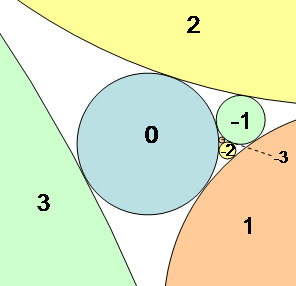
In geometry, Coxeter's loxodromic sequence of tangent circles is an infinite sequence of circles arranged so that any four consecutive circles in the sequence are pairwise mutually tangent. This means that each circle in the sequence is tangent to the three circles that precede it and also to the three circles that follow it.
Properties
The radii of the circles in the sequence form a geometric progression with ratio
The centres of the circles in the sequence lie on a logarithmic spiral. Viewed from the centre of the spiral, the angle between the centres of successive circles is[1]
The construction is named after geometer H. S. M. Coxeter, who generalised the two-dimensional case to sequences of spheres and hyperspheres in higher dimensions.[1][4][5] It can be interpreted as a degenerate special case of the Doyle spiral.[2]
See also
References
- ^ a b c Coxeter, H. S. M. (1968), "Loxodromic sequences of tangent spheres", Aequationes Mathematicae, 1 (1–2): 104–121, doi:10.1007/BF01817563, MR 0235456, S2CID 119897862
- ^ a b Aharonov, D.; Stephenson, K. (1997), "Geometric sequences of discs in the Apollonian packing", Algebra i Analiz, 9 (3): 104–140, MR 1466797
- ^ Kocik, Jerzy (January 2019), A note on unbounded Apollonian disk packings, arXiv:1910.05924
- ^ Coxeter, H. S. M. (1997), "Numerical distances among the spheres in a loxodromic sequence", The Mathematical Intelligencer, 19 (4): 41–47, doi:10.1007/BF03024413, MR 1488865, S2CID 120436625
- ^ Coxeter, H. S. M. (1998), "Numerical distances among the circles in a loxodromic sequence", Nieuw Archief voor Wiskunde, 16 (1–2): 1–9, MR 1645232






